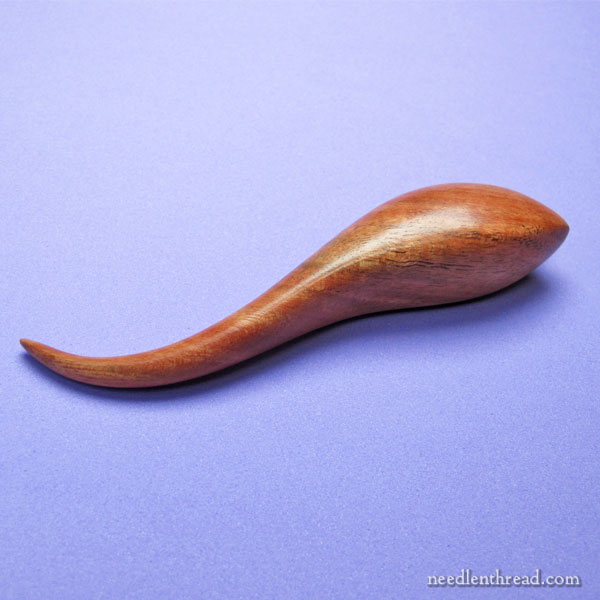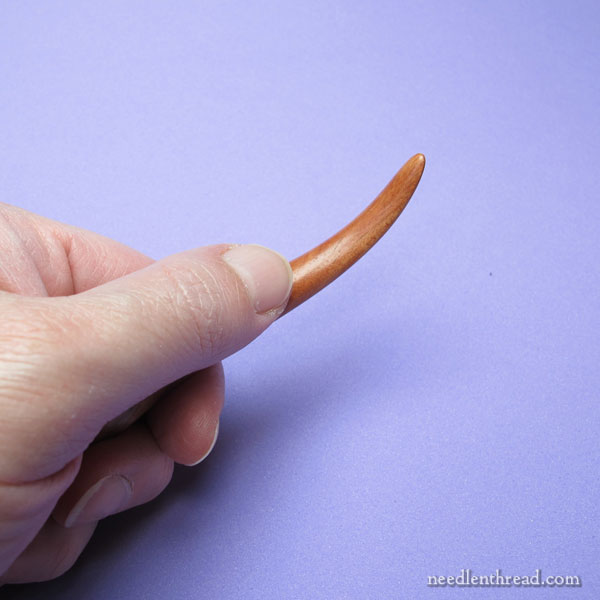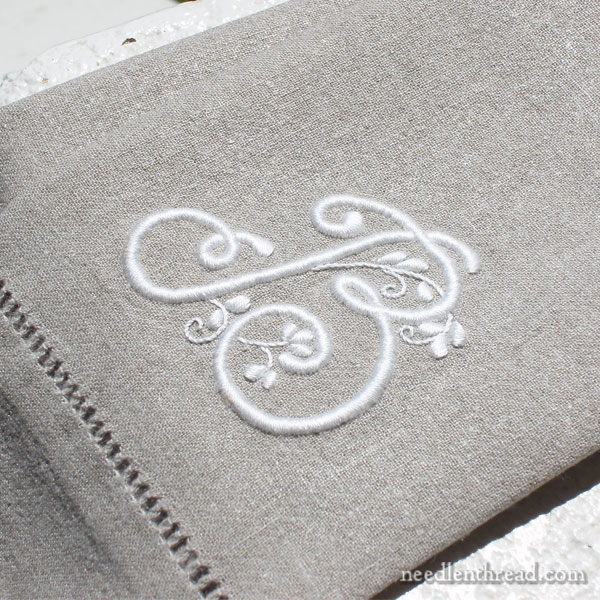When we chatted about our favorite embroidery tools a couple weeks ago, some readers brought up a tool called an aficot, which raised some virtual eyebrows out there and brought up a few questions.
Here in the States and among embroiderers, the aficot is not really a super well-known tool. It doesn’t come up in embroidery conversation much. It’s not a highly marketed tool. And it’s not that easy to find a nice aficot.
The aficot is more commonly used in lace-making, but it has its uses in embroidery, too. If you do a lot of whitework that involves satin stitching, or you love to satin stitch monograms or the like (in any color), you just might find an aficot very useful!
It’s also one of those tools that’s fun to have lying around, because people look at it and can’t help asking, “What is that thing?”
So, here’s a shot of my aficot. I’ll tell you a little about how it’s used and where you can find your own.

Such a lovely tool! I do so love beautifully made wooden tools.
The aficot is a tool that descends from the lobster claw. In lace making, particularly in Alençon lace, the lobster claw was used in two ways: 1. to polish raised threads, and 2. to smooth down areas of tape or fabric between lines of stitching, to make the stitching stand out better.
You can see, in this video on Alençon lace, the lobster claw in use for the latter purpose. You’ll see it sneak in very briefly around the 2:37 mark.
The aficot replaces the lobster claw. It can be made of material other than wood – for example, there are references in lace-making books to aficots made of steel – but the wooden aficot is more common.

The aficot fits right in your hand, and you can hold it comfortably just like this. I normally use it with my right hand, but you can hold it in either.
If you get a good one, I would venture to say it’s probably the most comfortable tool you’ll ever hold, because it just fits right into the palm of your hand perfectly and your thumb sits easily on the curve where the tool moves to a flat tip.
The key to a good aficot is that it must, absolutely, no matter what, be perfectly smooth. If it has any abrasiveness to it – any splintery area, any ridge from a molding (if it’s steel or any other material) – it will not do what it is intended to do, and in fact, it’ll do just the opposite.
So, how do you use it? Embroiderers use that flat, smooth, slightly curved tip to burnish or polish threads, especially raised satin stitching.

This is a monogram I worked a while ago on an old oat-colored linen towel.
This is the type of satin stitching that you’d use an aficot on.
Once the satin stitching is finished, you take the flat tip of the aficot, and you polish the threads lightly. You don’t have to push and prod them or use a lot of pressure on them. You just start at the base and polish up the sides and across the top of the stitching.
The stitches sort of meld together better – they cozy up next to each other and fill out the surface, making it super smooth.
Incidentally, if you don’t have an aficot, you can still polish your threads. If you have scissors that are well made (like these Dovo scissors or these Premax scissors), you can use the outer curve on the finger holes to polish your threads, as long as the steel is perfectly smooth.
Where to Find Aficots
Well, there’s the million dollar question! You’re probably not going to find an aficot at a local shop.
Here in the US, (updated 2017) I found my aficot through a woodworker named Michael at M & H Handcrafts, which is no longer a functional website and I don’t know where Michael went or if he is even making them anymore! He made his tools out of exotic hardwoods and they are simply gorgeous.
In the UK, I’ve seen aficots available through the Guild of Needle Laces. I’ve not tried theirs, so I don’t know what it’s like. But if you’re looking for one, you’ll find it there. They also have other interesting lace-making tools that the embroiderer can make use of, too.
It looks like you can also find them through Needle Paws in the UK. Again, I’ve not tried them or done business with them, but it’s worth checking out, if you’re looking for an aficot.
I’ve not been able to put my finger on a source in Australia or New Zealand, but maybe someone else knows of one and can mention it below?
And that, my friends, is the aficot.
Such a lovely tool!







There’s nothing quite like a tool that does the job and is beautiful to use, is there? The UK site (I’m in Scotland) is very interesting, and one I’d not visited before. Thanks, Mary! And here’s a bit of information from it: apparently original aficot (aficots?) were made from lobster’s claws, which would explain the shape. (Everyone needs a useless piece of information for the day.)
I have one of these and I use it to smooth vertical or horizontal satin stitches in needlepoint, also will work for diagonal gobelin or diagonal satin stitches. Pointed end may be used to gently push unruly threads into place.
If you find that you can’t afford or locate an aficot, might I suggest that a bone folder, as used in bookbinding, might make a half-decent stand-in? They are readily available from bookbinding suppliers, such as Shepherds in the UK, and are very cheap (from £4):
http://store.bookbinding.co.uk/store/category/39/334/Bone-%26-Teflon-Folders/
They are very, very smooth, have a point, and a nice curve so they fit in the hand well. And if you don’t like the idea of using a bone implement, you can get them in teflon too.
Lots and lots and lots and lots of lobsters are fished here, so I use the traditional lobster claw. They don’t fit the hand as beautifully as a wooden aficot, but they work well (and it’s a pleasure to eat the lobster).
P.S. “Aficot” is a French word and for those who don’t speak the language, the “t” is silent.
Thanks for the language note!
Dear Mary
I do love Tool talk and this is a very interesting piece of equipment and I’ve just ordered one at £10 I can afford this useful tool as once I have sewn a piece of embroidery I always polish my threads so this will come in handy for my future projects. I will browse the UK websites above some more as their tools look very interesting. Thanks for the information and use of this tool I can’t wait to receive it and start polishing away my threads will wonder what has happened as they will look so polished. Thanks for the information and for explaining the uses of the Aficot.
Regards Anita Simmance
Did you get your aficot from M & H Handcrafts? Some of his woods are truly beautiful – I Love the ebony and the bloodwood. I also find the “fine spiral” bone stiletto especially pretty.
Thanks for this clarification on aficots!
Sarah
Yes, I did! It’s the pink ivory wood. It’s … Lovely! In case I didn’t mention that (but I think I did!) 🙂
I love your site and posts. I’ve learned so much from them.
My question isn’t related to this post, but I was wondering what your thoughts are on the pall used for the Richard III reinterment? This link shows one side of it. I’d really be interested in hearing your thoughts about it.
http://www.theaustralian.com.au/news/world/a-glorious-return-for-richard-iii-one-of-historys-losers/story-fnb64oi6-1227274487248
Sadly that article is available only to subscribers and I am not one of them. Can you describe the pall please or do you know of another site where we can see it?
Oh, sorry – I mean to reply to this. The fiber artist who made it works with appliqué and machine embroidery. I think the whole event is quite interesting and I’ve been following it in the news. Her website is here, and you can see a photo of the full pall on her home page: http://www.jacquiebinns.com
I have an aficot from M & H that is so beautifully done. I’ve only had mine for a couple of years, but Michael is a fine craftsman and the tool is fantastic. My tool box also includes a lobster claw and a polished agate that has just the right point and angle. They’re all slightly different but one always fits the job at hand.
The half cone sticks sold by the Guild of Needlelaces are made by Needlepaws.
I believe this is also the case with the aficots.
I have had 2 sets of the half cone sticks and they are all beautifully made. I needed a replacement as my puppy had found and chewed some of the pieces, not because of any flaw in the workmanship. If you contact Needlepaws directly you may be given a choice of the woods he has in stock.
I’d highly recommend their products.
I have a gorgeous aficot, but have never used it for embroidery. I use it for bookbinding, when I have covers with raised motifs. It’s perfect for working around the more detailed parts of a design. I also did not know, until recently, that this piece of gear was called an aficot! I’ve always known it as a lobster claw.
Visited Alencon vieux ville in 1992 to see the museum “des les dentelles.” No photography permitted and the upstairs 30 cabinets of lace displays were totally in French but detailed steps shown for making famous Alencon lace. I became curious then in seeing their use of a crab’s claw to achieve the more raised relief surface by pressing the wrong side. You bring back those distant memories today.
Thank you for mentioning M & H Handcrafts. I have a whole set made by Michael Helmke and they’re fabulous. Mine are all “Iron wood” with bone tools set in the wood handles, a small holder for the set, an aficot, an all iron wood laying tool, a holder for a Japanese laying tool, and a brush to use with gold work. His tools are absolutely the best.
It’s been a long time and I don’t know a lot about wood, but I think Michael also called the type wood I have as snake wood. The whole set is beautiful — it’s a very dark brown and he said it is one of the hardest woods there is.
Oh, there is nothing as wonderful as the look of a piece of art in wood. Well, perhaps, the feel of it in the hand. And then being able to justify purchasing another laying tool… Ah, well, everyone needs an aficot just in case. Thank you for another articles that educates and expands our knowledge of the finer details of needlework!
Thank you for sharing your knowledge and expertise! I enjoy your posts immensely.
Well Mary you sorted out “what is that” for me. An Aficot.
I received years ago a box of lace makings and with the assortment of tools there were two of these funny little ‘comma things’. I haved used them at times but for an entirely different purpose. I use mine for smoothing the edge of leather. Before I stitch it. I also use the handle end of a pair of scissors.
I found it handy on silk ribbon like a little iron.
I have to say mostly I use what is at hand but I think they are dear little things and feel nice in the hand with their silky smoothness.
Thanks again for an interesting snippet of enlightenment.
My question is “Why has no one mentioned aficots before this?” I’ve been embroidering monograms for years and have a lot – I truly mean ‘a lot’- of books on monograms and embroidering monograms and not one, not one! mentions aficots. I’ve been gipped, lied to, and who knows what else. My next question is, What other secrets have you been keeping from us?
Mary,
Thanks for sharing this. It will be nice to try out and take the satin stitching to the next level. You do such a great job of keeping us all up to date with great items.
Carrie
What an interesting and unusual tool. It makes you want to pick it up! Thank you for showing it to us, I would have had no idea what it was for or how to use it. 🙂
Hi Mary,
Could you elaborate in another post what it means to “polish” threads?
Thanks,
Carrie PlaneNut
Pleasant surprise – researching of burnishing satin stitch brings me right back to you.
Thank you again.
I have an aficot from Michael and I can vouch for the tool and his work. In fact, I have a complete set of tools from him and two are special requests. I’m ordering a few more things from him and noticed when I talked with him that the stand for my first tools from him was numbered #001, and had his name on the bottom. Nifty!
How long is an aficot and how wide is the bulb part of it? Just wondering because I think I am going to play with a piece of wood and see if I can fashion one.
Hi, Sarah – I emailed you the information….
It seems Michael does not have a website anymore. It opens to a GoDaddy site.
Karen
Thanks, Karen – I’ve updated that now!
I make , among other fiber related tools hedebo sticks, aficots, laying tools, half cone sticks etc. My wife spotted your web site and thought that perhaps I should let you know that they are available here in Australia. Thought I should add my name instead of being anonymous.
Regards,
Dave Brown.
Hi, Dave – thanks for leaving your comment! For some reason, your link to your shop doesn’t work – it just lands me at an Oops Not Found page on Etsy. :-/
We’ve recently purchased aficots through Lacis in the USA and now stock them at The Stitcher’s Muse in Canada.
In Australia, Alison Cole Embroidery are now selling Aficots. (You can find them here.)
You can find either ebony or rosewood aficots at Hand Embroidery Supplies in Queensland, Australia.I have dealt with them several times and found them really good.
Available in Australia from Hand Embroidery Supplies
While this is an older post, I wanted to mention that you can purchase a wooden aficot from Trillium Lace in Canada.
Could you add me to your newsletter list,and
Could you tell me the cost of agicot tool
I live in australia
Hi, Helen – Thanks for your interest in my newsletter! You can sign up for that here: https://needlenthread.wpengine.com/newsletter-signup There’s also a form on the left column of the website.
The cost of an aficot depends on where you get it, who made it, etc. They can range from somewhat inexpensive, make in India or similar, to rather expensive hand-tooled, hand-finished with artisan touches, out of quality wood. So the cost really just depends.
merci ;grâce à vous j’ai reçu ce matin pour la fête des mères une belle surprise :un aficot et l’outil l’accompagnant ;mon époux a commandé aux U.S.A ces petites merveilles.
Merci pour tout.
When in Oaxaca de Juárez, Oaxaca, México (southern México) I often participate in weaving and embroidery workshops. During one the instructor lent me a cactus spine to use similarly to the alficot. It had been used for years after having been smoothed by removing the rough edges that spine often have. It was a delight to use, but it was the only one that she had — it wasn’t for sale at any cost. On my next trip I’m determined to acquire one for use at home.
aficots may also be found on Etsy – there is presently more than one maker selling.
Thank you for your explanation of the aficot. I look forward to finding one! Cheers!
I just learned about the aficot and look forward to sourcing this tool and becoming acquainted with using it!
Thank you!